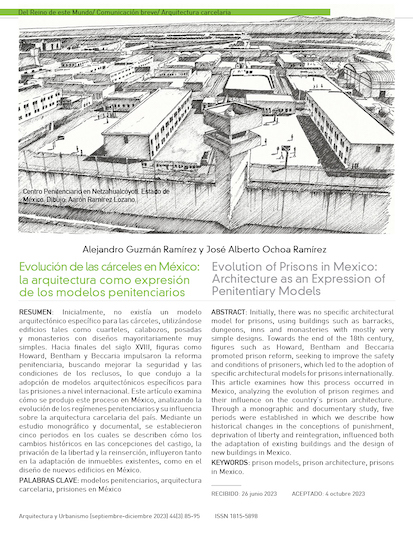Evolution of Prisons in Mexico: Architecture as an Expression of Penitentiary Models
Keywords:
prison models, prison architecture, prisons in MexicoAbstract
Initially, there was no specific architectural model for prisons, using buildings such as barracks, dungeons, inns and monasteries with mostly very simple designs. Towards the end of the 18th century, figures such as Howard, Bentham and Beccaria promoted prison reform, seeking to improve the safety and conditions of prisoners, which led to the adoption of specific architectural models for prisons internationally. This article examines how this process occurred in Mexico, analyzing the evolution of prison regimes and their influence on the country's prison architecture. Through a monographic and documentary study, five periods were established in which we describe how historical changes in the conceptions of punishment, deprivation of liberty and reintegration, influenced both the adaptation of existing buildings and the design of new buildings in Mexico.
References
Ruiz-Morales, Manuel L. La arquitectura penitenciaria como representación del castigo. Las maneras de comprender la pena de prisión en la historia. Política criminal, 2020:15(29), 406-449. https://dx.doi.org/10.4067/S0718-33992020000100406
Mendoza Bremauntz E. Derecho penitenciario. Serie jurídica. México: Mc Graw Hill; 1998.
Malo Camacho G. Historia de las cárceles en México. México: Instituto Nacional de Ciencias Penales; 1988.
Carranca y Rivas R. Derecho Penitenciario. Cárcel y penas en México. México: Porrúa; 1981.
Díaz Herrera MA. La víctima: un recuento histórico de su papel en el proceso penal. Revista Iter criminis. 2004; (9): 127-55.
García Ramírez S. Manual de prisiones: la pena y la prisión. 2da ed. México: Porrúa; 1980.
Barrón Cruz MG. Una mirada al sistema carcelario mexicano. México: Instituto Nacional de Ciencias Penales; 2002.
Padilla Arroyo A. De Belem a Lecumberri. Pensamiento social y penal del México decimonónico. México: Archivo General de la Nación; 2001.
Mendoza Bremauntz E. Derecho penitenciario. Serie jurídica. México: Mc Graw Hill; 1998.
Villanueva Castilleja R, Labastida Díaz A. Consideraciones básicas para el diseño de un reclusorio. México: Procuraduría General de la República; 1994.
Barrón Cruz MG. Una mirada al sistema carcelario mexicano. México: Instituto Nacional de Ciencias Penales; 2002.
García Ramírez S, Martínez Breña L. Presos y prisiones. El sistema penitenciario desde la perspectiva de los derechos humanos. México: Porrúa/UNAM; 2014.
Sánchez Galindo A. Penitenciarismo. La prisión y su manejo. México: Instituto Nacional de Ciencias Penales; 1991.
Labastida Díaz A. El sistema penitenciario mexicano. 2da ed. México: Delma; 2000.
Fernández Muñoz D. Actualidad y futuro de la pena de prisión. Cuadernos del Instituto de Investigaciones Jurídicas. 1989; 4(10):137-54.
Marco del Pont L. Derecho Penitenciario. México: Cárdenas; 1984.
Guerrero Durán E. Prisiones en México. Memoria Visual y Escrita. Comisión Nacional de Seguridad – Secretaría de Gobernación. México: Editorial DGE / El Equilibrista; 2016.
Larrea González I.· Arquitectura penitenciaria. Efectos del encarcelamiento. Universidad Politécnica de Madrid, 2021. https://oa.upm.es/66597/1/TFG_Ene21_Larrea_Gonzalez_Itxaso.pdf
Rodríguez Manzanera L. La crisis penitenciaria y los substitutivos de la prisión. 3ra ed. México: Porrúa; 2004.
Méndez Paz L. Derecho Penitenciario. Colección textos jurídicos universitarios. México: Oxford University Press; 2008.
Méndez Lecona Fernando. La arquitectura carcelaria y la readaptación social. El caso de los reclusorios de la capital mexicana (1971-1976) Revista de Historia de las Prisiones 2020:1 (11) 7-27. https://www.revistadeprisiones.com/wp-content/uploads/2020/12/1.-Fernando-Mendez-Lecona.pdf

Downloads
Published
How to Cite
Issue
Section
License
Copyright (c) 2023 Revista científica de Arquitectura y Urbanismo

This work is licensed under a Creative Commons Attribution-NonCommercial-NoDerivatives 4.0 International License.
a. The authors retain the copyright and guarantee the magazine the right to be the first publication of the work as well as a Creative Commons Attribution License that allows others to share the work with an acknowledgment of the authorship of the work and the initial publication in this magazine.
b. Authors may separately establish additional agreements for the non-exclusive distribution of the version of the work published in the journal (for example, place it in an institutional repository or publish it in a book), with an acknowledgment of its initial publication in this journal.
c. Authors are allowed and encouraged to disseminate their work electronically (for example, in institutional repositories or on their own website) before and during the submission process, as it can lead to productive exchanges, as well as a more early and major published papers (See The Effect of Open Access, in English).

